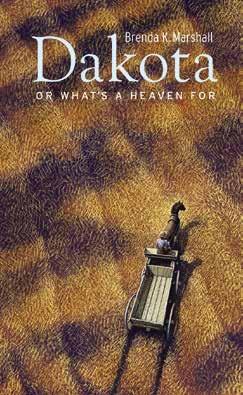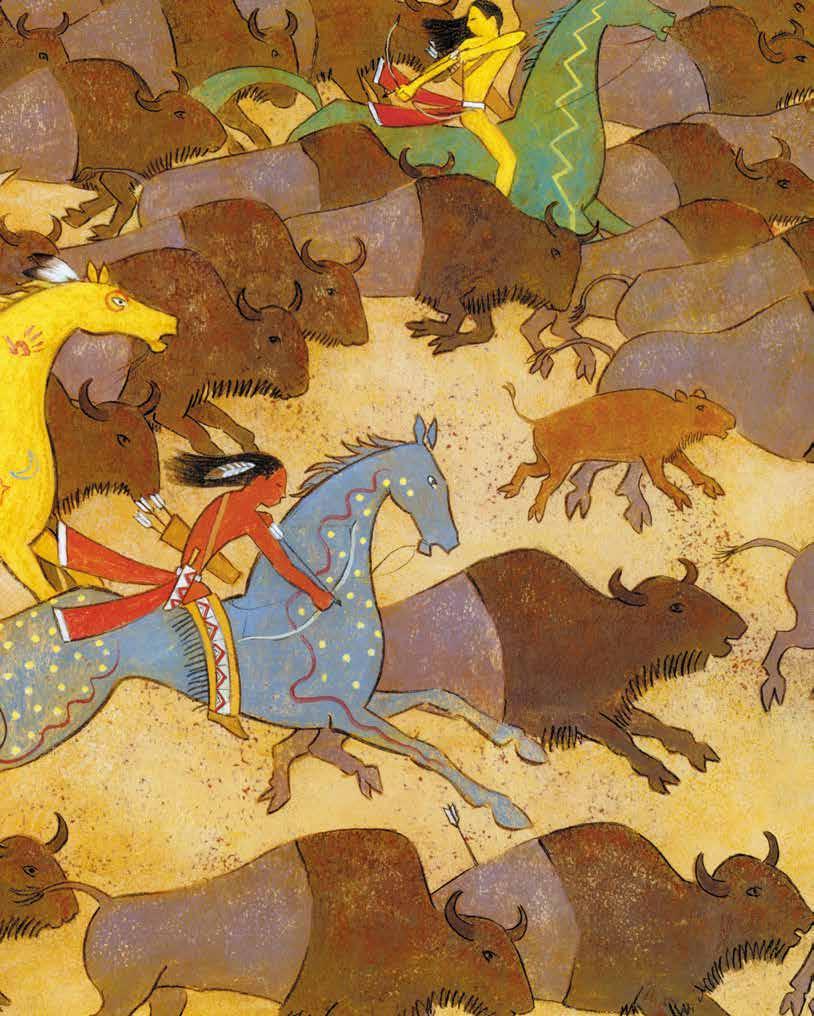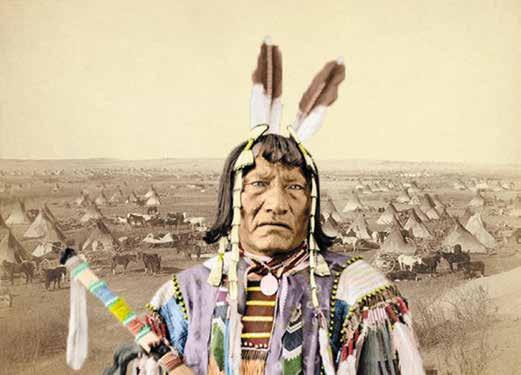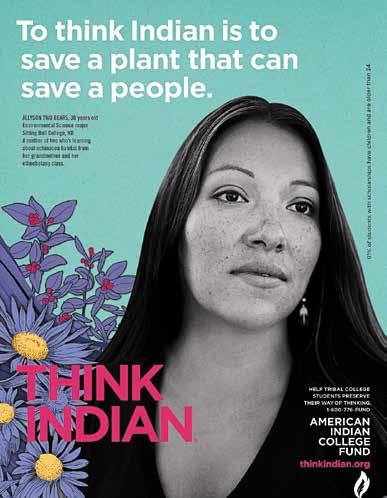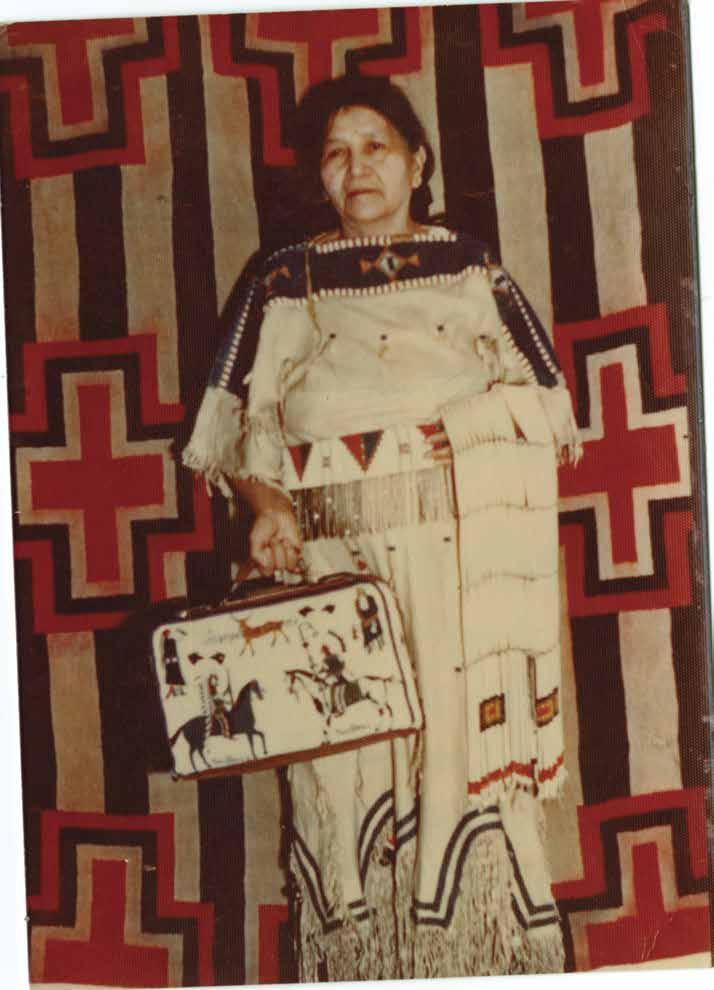
13 minute read
A Tale of Two Schools
It is fall 2009. We have a brand new high school and it is busy creating crisp new traditions: spirit weeks, fall and winter dances, a mascot (a frightfully bland eagle), team colors (blue and white, naturally) and a whole range of quasi-academic traditions such as the yearbook and the annual musical theater production. The school has been crafted in the moment of multiculturalism and diversity in American education. It has an African American principal, a diverse workforce, and a student body that is both “hyphenated-American” and international in scope. The school is very sensitive to cultural difference—or so it seems.
For the annual musical, the theater director chooses the 1946 Irving Berlin musical, Annie Get Your Gun. It takes as its setting Buffalo Bill’s Wild West show, and it concerns a romance between the trick sharpshooters Annie Oakley and Frank Butler. During the 1885-86 season, the Lakota Sioux leader Sitting Bull traveled with the Wild West and he came to know and apparently like Annie Oakley—which is how he comes to be one of the characters in the musical. No one at the school gives this a second thought.
Advertisement
How Do We (Not) Think About American Indians in American History?: A Tale of Two Schools
By Philip J. Deloria
Philip J. Deloria is the Carroll Smith-Rosenberg Collegiate Professor of History and American Studies and Associate Dean for Undergraduate Education in the College of Literature, Science, and the Arts at the University of Michigan. He is the author of Playing Indian (1998) and Indians in Unexpected Places (2004), as well as numerous articles and essays. A former president of the American Studies Association, he is currently a trustee of the National Museum of the American Indian.
The original script, by Dorothy and Herbert Fields, is rich with the kind of comic schtick that migrated from vaudeville to mid-century stages and film studios, and Sitting Bull serves as one of the primary vehicles for the fast-paced banter (that’s a “heap big heap” of money, he says at one point; or “Great White Father is Indian Giver”—it’s that kind of talk). Some of the original material—the song “I’m an Indian Too,” for example— has become so dated that it has been removed from contemporary productions as offensive. Indeed, the high school students perform a 1999 rewrite that aims to ameliorate these kinds of concerns.
When they see the actual script, however, some of the high school parents feel that the rewriting has not gone far enough and that, even if the lines and the lyrics have been mildly updated, the ways in which student actors are performing the Indian characters reflects old stereotypes. They press the issue with administrators and are disappointed by the school’s response: the music is so good (it is an Irving Berlin musical, after all!) and it has been updated (said slowly and patiently, as if to a small child) so that anything offensive has surely been removed. With these changes in mind, says the school, the overriding issue at stake is not really “cultural sensitivities” but rather freedom of artistic expression for the students and director.
Here’s the crux of the matter. “Freedom of expression” is translated quickly into “freedom of speech,” which means that the exchange becomes (ironically, given the tendencies of the American high school to censor its students) an issue of civil rights. The slippage happens almost unconsciously. In the context of the multiculturalism wrought by four decades of civil rights activism—the context of the school itself—“civil rights” is a particularly powerful position from which to argue. One by one, parents peel away from the protesting group. But there is bewilderment in the air. Parents are surprised at how easily a multicultural school proves unable to imagine that its diversity might include American Indian students or that the local community might include American Indian people. This, after all, is a school that refused to let its athletic teams wear black (which the students argue, would go so well with the rather wimpy blue and white), for fear of the racialized meanings that might inhere in football or softball uniforms.
As surprising, however, is the way that the language of the debate moved so seamlessly from pleas for cultural sensitivity to the First Amendment rights of students and teachers to say, or perform, what they wanted. Two central languages of multiculturalism—“respect for others” and “constitutional civil rights”—were pitted against one another, and civil rights was the clear winner.
I sent my letter of protest to the school (four pages, with illustrations!), where it was promptly ignored. I brooded all fall. I started wondering about the politics of race at the school, which focused, quite naturally, on its substantial African American population. And I started thinking about the ways that a second school— my school, the University of Michigan—maybe had something to do with the invisibility of Indian people at the high school. In partnership with college and university history departments across the continent, our history department constantly frames for students the big, significant stories of American history. Those students then go on to become teachers, principals, musical theater directors, and parents. The story they have in their head comes out of those history courses. They’re mostly about White Americans. But when they’re not, they’re mostly about Black Americans—and thus, about civil rights. How does this happen?
In the history department where I teach, we divide our survey of United States history into two halves. The first runs from the dawn of time through the Civil War and Reconstruction; the second begins with Reconstruction and runs to the near-present. When we discuss teaching assignments, the consequences of this division become clear: the first half is relatively simple to teach and there are willing volunteers; the second half is more difficult and fewer hands are raised. Why is the first half “simple?” It has a relatively clean storyline, which is centered on the sectional conflict between North and South that culminated in the Civil War. One easily and naturally begins the class on the field at Gettysburg, recounting the story of Pickett’s Charge, that frightening battlefield moment when Confederate soldiers marched across over a mile of open field, chewed to pieces by Union fire before they even reached the enemy positions. Why, you ask the students, would men do such a thing?
That single question, easily understood and yet utterly mystifying, opens up the entire sweep of United States history in a most compelling way. Why the Civil War? Why these sections called North and South? Why this question of states’ rights? Why slavery? How did it work? Where did it come from? The questions—so
natural, so pressing, so important—guide you back through the nineteenth century to the developing of differential economies among North and South, the fatal compromises built into the founding documents of the republic, the family and labor systems that developed out of colonial settlement, the middle passage and triangle trade, the development of a Black Atlantic, the creation of the South as a slave-based society.
The Civil War offers teachers, students and readers a narrative hook that gives shape and definition to a vast amount of history. It establishes a framework that students find useful and familiar. First settlements, Indian Wars, and colonial land-taking become preludes to the story that leads to the Civil War. The elimination of the Spanish, French, and English from what would become the United States—these things, too, are merely warmups for the story of the preconditions that produced the war, that great divider of American time, space, memory, and culture. The great West becomes not a coherent region in and of itself—a place full of American Indian people and their social and political structures—but an empty space, the site of the colonial expansion that will bring sectional crisis to a boil.
We teach the Civil War as the effect of a complex series of historical causes. And then, we turn around and teach it as a kind of cause in and of itself. Think of what the Civil War produced: the Thirteenth, Fourteenth, and Fifteenth Amendments, Reconstruction and its failure, the rise of Jim Crow segregation, North-South (white) reconciliation, new conquests in the West and overseas, new forms of Black culture and politics, and eventually the twentieth-century civil rights movements.
The second part of the U.S. history survey is complicated by other factors—European wars, economic depressions, overseas expansion. But it is also true that the racial questions generated and left unresolved by the Civil War make up an important part of the storyline. Indeed, when teaching this second half of U.S. history, one is tempted to mark out the beginning of the class with the assertion of black civil rights reflected in the thirteenth, fourteenth, and fifteenth amendments, and then mark as an endpoint the twentieth-century black civil rights movement that gave us desegregation, voting rights, and Martin Luther King, Jr. (with of course an update that carries us forward to Barack Obama). It’s a powerful story, true and critical to an American self-understanding.
The freedom of speech argument wielded to defend Annie Get Your Gun from those who found it inappropriate was powered by this particular way of telling the story. Here are its central elements: The Civil War (and we’ll be hearing a lot about the war as we head into the sesquicentennial celebrations—is the hinge-point for American History. The war was about states’ rights, but it was (if we’re honest with ourselves) mostly about slavery and about the ways the nation has struggled—with difficulty, but also with a certain kind of nobility and a measure of success—to overcome the burden of a history of unfreedom and inequality. What else? This particular American struggle was conducted mostly by African American people and their goal was civil rights and citizenship.
When we think of other American minorities, it is almost impossible not to place them in this framework, as people struggling for the same goals of citizenship and equal opportunity. The Fourteenth amendment, to trace one example, offers the political grounding for most discussions of citizenship, and its promise of equal protection under the law has become a commonsense value. In the post-Reconstruction world of the late nineteenth century, “equal protection” went away and most white Americans embraced the “separate but equal” doctrine that underpinned Jim Crow segregation. The institutions and practices that supported segregation and discrimination (schools, employers, voting rights, housing and the like) served as targets for a wide range of people. But in the context of that powerful American historical narrative, one can see clearly how the African American experience— understood in terms of the movement from slavery to freedom to civil rights—gives direction and form to the stories of other groups of people. The movements are clear and compelling: from discrimination to equal protection; from alien immigrant to national citizen; from otherness to belonging, from segregation to integration, from dangerous inequality to equality and freedom.
Such stories are deeply powerful, for they carry readers from something bad to something better. They emphasize agency, progress and possibility. They have intelligible goals: liberty, recognition, civil rights, economic survival (and perhaps even prosperity), collective healing from historical trauma, a more just and equitable world. They frame our very language and our ability to think about what is possible and desirable—of course equality is what we want; of course civil rights are shared objects of struggle and desire.
But are they? Can this story be applied to American Indian people as readily as it seems to apply to everyone else? Maybe not.
In a technical sense, that same Fourteenth Amendment that promises black equality also works to pry apart African American and Native American narratives. It modifies—but also follows—Article 1, Section 2 of the United States Constitution. That original passage names four categories of American people: free people (that is, “citizens”—always an uncertain term in that the exercise of citizenship could be restricted on the basis of gender and wealth), indentured servants, “Indians not taxed,” and “all other persons.” This last is the oblique reference to slavery in the famous passage counting slaves as three-fifths of a person when determining congressional representation. The Fourteenth Amendment requires the counting of the “whole number of persons” (rather than three-fifths!) but it too excludes “Indians not taxed.” American Indians, in other words, don’t fit into the Constitution in the same way that African Americans do.
In this citizenship gap, you can see unfolding another history, one that doesn’t fit neatly into the story of the Civil War and civil rights. The phrase “Indians not taxed” raises, first, the question of collective rights as opposed to individual ones. By excluding Indians, it insists that civil rights are individual rights, while Indian rights—such as they are—emerge through a distinct political collective. For an Indian to be taxed (and thus, perhaps, to become a citizen), he or she had to renounce tribal membership, and take up an individual parcel of land (which was then subject to taxation). Those other people—“Indians not taxed”— remained part of a tribal collective, and thus outside of the story of the rights and equality. (Though other groups have struggled collectively for those rights, the rights themselves have been exercised by individuals.) Indeed, as many commentators have made clear, Indian people are extra-constitutional. As distinct and independent nations, they were never part of the original constitutional framework. To the extent that Indian political collectives exist under the rubric of the Constitution, they have been brought within its frame through other means, all of which rely upon the assertion that Congress has, in the end, absolute plenary power over Indians, as both tribal nations and—through their tribal designation as Indians—as individuals.
Tribal people, lawyers, and political theorists have all spoken and written extensively about the tensions between collective tribal national rights, as embodied in treaties, and the place of individual tribal citizens. That’s a different story, one that centers tribal sovereignty and its practice. It is, however, the story that points back to the American high school. My daughter began taking the United States history course in the brand-new high school. She used a widely acclaimed textbook, written by highly respected historians. Her teacher was solid and committed. And the course exemplified exactly what I’d been thinking. The book hinged the entire course on the Civil War. When it wasn’t a white story, it was mostly a black story. When it came to American Indians, not only were there errors of fact and chronology, but there was no effort made to outline an alternative story, a bigger analytical framework, an interpretation that challenged these others.
How could anyone be surprised, then, when Annie Get Your Gun seemed like a good idea? Or when few people in the high school community could imagine American Indians as students or neighbors? Or when civil rights and free speech trumped American Indian efforts to challenge their representation on the high school stage? These scenes play themselves out across the length and breadth of the United States, and they do so, in part, because we’ve come— appropriately—to value certain stories so much that they overwhelm other possibilities.
An equally big alternative story exists, and it can and must be told. In that story, the conquest of the North American continent is as important as the enslavement of Africans; Indian Removal is as important as Reconstruction; sovereignty is as important as civil rights; the Native American Renaissance as important as the Harlem Renaissance. These stories, it turns out, have many points of linkage and connection: Indian slaveowners, crossracial black-Indian marriage, shared and contested political alliances, cultural slippages and exchanges. And both sets of stories, we should not forget, are every bit as important as the old familiar chestnuts, Civil War and the pioneer settling of the West.
If our history was utopia, we could look back, as if from a high hill, and see a proliferation of these stories simultaneously, intricately interlocked, rich with human complication. Lacking that view, however, it’s important to keep in mind that the stories we choose to tell have consequences in the world. High schools perform musicals, students learn what they take to be gospel truth, and we all grow up to make the stories we’ve heard real. We act on them and repeat them and teach them until they have a solidity that keeps us from thinking about and seeing our lives and our worlds in new ways. We can do better.

